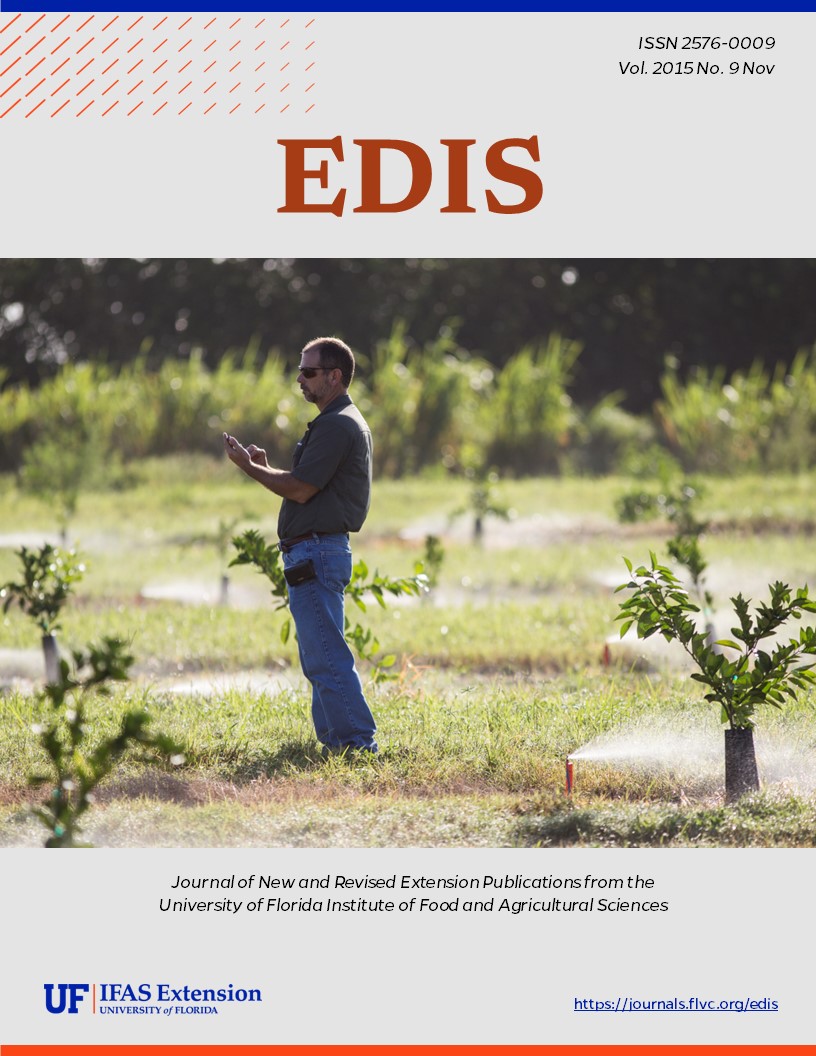Abstract
This EDIS publication is an alternate version of a page published first on the Featured Creatures website. The Featured Creatures collection provides in-depth profiles of insects, nematodes, arachnids and other organisms relevant to Florida. These profiles are intended for the use of interested laypersons with some knowledge of biology as well as academic audiences. This 5-page fact sheet that discusses the Florida flower thrips was written by Steven P. Arthurs, Moh Leng Kok-Yokomi, and Hugh Smith, and published by the UF Entomology and Nematology Department, November 2015.
References
Ananthakrishnan TN. 1993. Bionomics of thrips. Annual Review of Entomology 38: 71-92. https://doi.org/10.1146/annurev.en.38.010193.000443
Avila Y, Stavisky J, Hague S, Funderburk J, Reitz S, Momol T. 2006. Evaluation of Frankliniella bispinosa (Thysanoptera: Thripidae) as a vector of the Tomato spotted wilt virus in pepper. Florida Entomologist 89: 204-207. https://doi.org/10.1653/0015-4040(2006)89[204:EOFBTT]2.0.CO;2
Chellemi DO, Funderburk JE, Hall DW. 1994. Seasonal abundance of flower-inhabiting Frankliniella species (Thysanoptera: Thripidae) on wild plant species. Environmental Entomology 23: 337-342. https://doi.org/10.1093/ee/23.2.337
Childers CC, Beshear RJ. 1992. Thrips (Thysanoptera) species associated with developing citrus flowers in Florida and a key to adult Terebrantian females. Journal of Entomological Science 27: 392-412. https://doi.org/10.18474/0749-8004-27.4.392
Childers CC, Brecht JK. 1996. Colored sticky traps for monitoring Frankliniella bispinosa (Morgan) (Thysanoptera: Thripidae) during flowering cycles in citrus. Journal of Economic Entomology 89: 1240-1249. https://doi.org/10.1093/jee/89.5.1240
Childers CC, Beshear RJ, Frantz G, Nelms M. 2005. A review of thrips species biting man including records in Florida and Georgia between 1986-1997. Florida Entomologist 88: 447-451. https://doi.org/10.1653/0015-4040(2005)88[447:AROTSB]2.0.CO;2
Childers CC, Nakahara S. 2006. Thysanoptera (thrips) within citrus orchards in Florida: Species distribution, relative and seasonal abundance within trees, and species on vines and ground cover plants. Journal of Insect Science 6: 45. https://doi.org/10.1673/031.006.4501
Demirozer O, Tyler-Julian K, Funderburk J, Leppla N, Reitz S. 2012. Frankliniella occidentalis (Pergande) integrated pest management programs for fruiting vegetables in Florida. Pest Management Science 68: 1537-1545. https://doi.org/10.1002/ps.3389
Fisher JB, Davenport TL. 1989. Structure and development of surface deformations on avocado fruits. HortScience 24: 841-844. https://doi.org/10.21273/HORTSCI.24.5.841
Frantz G, Mellinger HC. 1990. Flower thrips (Thysanoptera: Thripidae) collected from vegetables, ornamentals and associated weeds in South Florida. In Proceedings of the Florida State Horticultural Society 103: 134-137.
Funderburk C, Funderburk J, Tyler-Julian K, Srivastava M, Knox G, Andersen P, Adkins S. 2015. Population dynamics of Frankliniella bispinosa (Thysanoptera: Thripidae) and the predator Orius insidiosus (Hemiptera: Anthocoridae) as influenced by flower color of Lagerstroemia (Lythraceae). Environmental Entomology, in press. https://doi.org/10.1093/ee/nvv057
Funderburk J. 2009. Management of the western flower thrips (Thysanoptera: Thripidae) in fruiting vegetables. Florida Entomologist 92: 1-6. https://doi.org/10.1653/024.092.0101
Hoddle MS, Mound LA, Paris DL. (2012). Thrips of California. CBIT Publishing, Queensland. (14 September 2015).
Lewis T. 1997. Thrips as Crop Pests. Cab International, Wallingford, UK, 740 pp. https://doi.org/10.1079/9780851991788.0000
Northfield TD, Paini DR, Funderburk JE, Reitz SR. 2008. Annual cycles of Frankliniella spp. (Thysanoptera: Thripidae) thrips abundance in north Florida uncultivated reproductive hosts: Predicting possible sources of pest outbreaks. Annals of the Entomological Society of America 101: 769-778. https://doi.org/10.1093/aesa/101.4.769
PaDIL http://www.padil.gov.au. (15 September 2015). https://doi.org/10.14710/reaktor.15.4.213-217
Paini DR, Funderburk JE, Reitz SR. 2008. Competitive exclusion of a worldwide invasive pest by a native. Quantifying competition between two phytophagous insects on two host plant species. Journal of Animal Ecology 77: 184-190. https://doi.org/10.1111/j.1365-2656.2007.01324.x
Ramachandran S, Funderburk J, Stavisky J, Olson S. 2001. Population abundance and movement of Frankliniella species and Orius insidiosus in field pepper. Agricultural and Forest Entomology 3: 129-137. https://doi.org/10.1046/j.1461-9563.2001.00097.x
Rhodes EM, Liburd OE, England GK. 2012. Effects of southern highbush blueberry cultivar and treatment threshold on flower thrips populations. Journal of Economic Entomology 105: 480-489. https://doi.org/10.1603/EC11265
Tsai JH, Yue BS, Funderburk JE, Webb SE. 1995. Effect of plant pollen on growth and reproduction of Frankliniella bispinosa. Tospoviruses and Thrips of Floral and Vegetable Crops 431: 535-541. https://doi.org/10.17660/ActaHortic.1996.431.50
Tyler-Julian K, Funderburk J, Frantz G, Mellinger C. 2014. Evaluation of a push-pull strategy for the management of Frankliniella bispinosa (Thysanoptera: Thripidae) in bell peppers. Environmental Entomology 43: 1364-1378. https://doi.org/10.1603/EN14048
Watson JR. 1923. The proper name and distribution of the Florida flower thrips. The Florida Entomologist 7: 9-11. https://doi.org/10.2307/3492861

